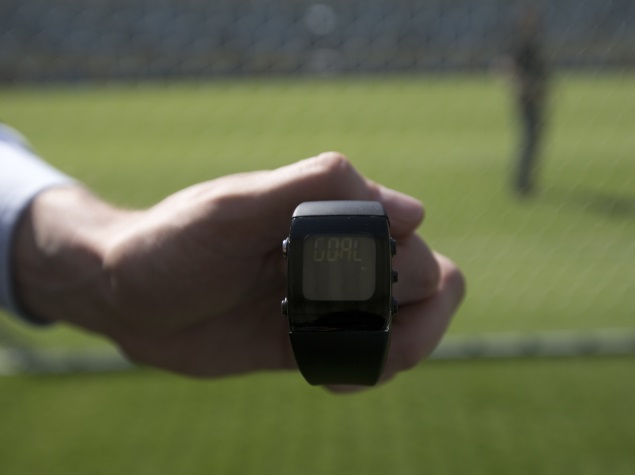- Home
- Science
- Science News
- Fifa World Cup 2014 Goalline Technology Deemed 'Unhackable'
Fifa World Cup 2014 Goalline Technology Deemed 'Unhackable'

It will come as welcome news to the likes of Frank Lampard who famously had a goal ruled out in England's second round match against Germany in South Africa in 2010 despite the ball clearly crossing the line.
GoalControl, the official provider of the system, re-tested the technology at Rio's Maracana stadium the venue of the World Cup final in April ahead of the tournament which starts on Thursday.
(Also see: Fifa World Cup 2014 to Feature Goal-Line Technology)
"It is 100 percent accurate. The system will work," Dirk Broichhausen, managing director of GoalControl, said at a presentation at the Maracana.
World governing body FIFA awarded the contract to the German company 16 months ago and there will be 14 high-speed cameras at each of the 12 World Cup stadiums to determine if an attempt on goal has crossed the line or not.
There are seven cameras trained on each goal and the cameras each take 500 pictures per second, sending a "GOAL" message to the referee's watch if the ball is in, GoalControl chairman Bjoern Lindner explained.
(Also see: Football Gets 'GoalControl' Tech Makeover for Brazil World Cup)
He stressed, however: "The referee has the last call. He can override the system any time he wants. But he knows the system is reliable."
FIFA tested out GoalControl last year at the Confederations Cup, the World Cup dress rehearsal in Brazil, where it accurately detected each goal.
If the ball does not cross the line then the game will simply continue.
The cameras, fitted out with the latest in sensor technology, are stationed on catwalks around the stadium and measure the position of the ball every two milliseconds to within accuracy of as little as 0.5cm (0.2 inches).
The data is then transmitted over an encrypted system with Broichhausen insisting the technology could not be hacked.
(Also see: How to Watch Fifa World Cup 2014 Online)
"The system is offline there is no possibility to manipulate. We did a lot of internal and external testing I think more than 10,000 shots," he said.
FIFA spokesman Johannes Holzmueller concluded that "we can absolutely trust" the system to work and added it was designed to support and protect referees from the kind of controversy which accompanied Lampard's "goal" that wasn't validated against Germany, despite bouncing more than a metre over the line having come down off the underside of the bar, presaging a 4-1 eventual defeat.
At the time of Lampard's strike, the score was 2-1.
For the latest tech news and reviews, follow Gadgets 360 on X, Facebook, WhatsApp, Threads and Google News. For the latest videos on gadgets and tech, subscribe to our YouTube channel. If you want to know everything about top influencers, follow our in-house Who'sThat360 on Instagram and YouTube.
Related Stories
- Amazon Great Indian Festival 2024
- Big Billion Days 2024
- Apple Vision Pro
- Oneplus 12
- iPhone 14
- Apple iPhone 15
- OnePlus Nord CE 3 Lite 5G
- iPhone 13
- Xiaomi 14 Pro
- Oppo Find N3
- Tecno Spark Go (2023)
- Realme V30
- Best Phones Under 25000
- Samsung Galaxy S24 Series
- Cryptocurrency
- iQoo 12
- Samsung Galaxy S24 Ultra
- Giottus
- Samsung Galaxy Z Flip 5
- Apple 'Scary Fast'
- Housefull 5
- GoPro Hero 12 Black Review
- Invincible Season 2
- JioGlass
- HD Ready TV
- Laptop Under 50000
- Smartwatch Under 10000
- Latest Mobile Phones
- Compare Phones
- Nubia Z70 Ultra
- Vivo Y300 5G
- Red Magic 10 Pro+
- Red Magic 10 Pro
- Asus ROG Phone 9
- Asus ROG Phone 9 Pro
- ZTE Blade V70
- Vivo Y18t
- Asus Zenbook S 14
- MacBook Pro 16-inch (M4 Max, 2024)
- Huawei MatePad 11.5
- Acer Iconia Tab 10.36 (iM10-22)
- Redmi Band 3
- Xiaomi Smart Band 9 Pro
- Sony 65 Inches Ultra HD (4K) LED Smart TV (KD-65X74L)
- TCL 55 Inches Ultra HD (4K) LED Smart TV (55C61B)
- Sony PlayStation 5 Pro
- Sony PlayStation 5 Slim Digital Edition
- Carrier 2.0 Ton 5 Star Inverter Split AC (24K EMPERIA LXI INV)
- Lloyd 2 Ton 3 Star Inverter Split AC (GLS24I36WGVR)

















